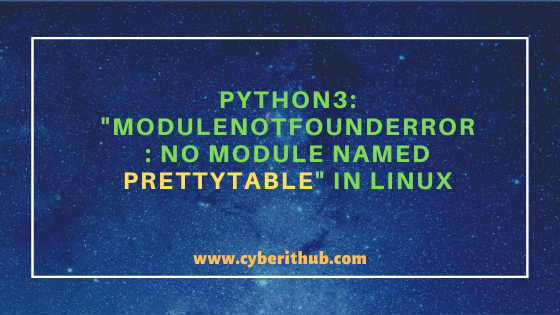- No Module Named Docker Ansible
- Importerror No Module Named Docker
- No Module Named 'docker' Airflow
- No Module Named Docker.errors
- Docker No Module Named Pymysql
Use Azure Container Instances to run serverless Docker containers in Azure with simplicity and speed. Deploy an application to a container instance on-demand when you don't need a full container orchestration platform like Azure Kubernetes Service.
ImportError: No module named flask. But their solutions aren't helpful. In my case using Docker, my.env file was not copied, so the following env. The rest of the document will use the docker command line. You can quite simply adapt your configuration into a docker-compose.yml file if you wish to do so. Configuration Data Store. GitLab is a code hosting software and as such you don't want to lose your code when the docker container is stopped/deleted.
In this quickstart, you use Azure PowerShell to deploy an isolated Windows container and make its application available with a fully qualified domain name (FQDN). A few seconds after you execute a single deployment command, you can browse to the application running in the container:
If you don't have an Azure subscription, create a free account before you begin.
Bootcamp dmg for mac. Note
This article has been updated to use the Azure Az PowerShell module. The Az PowerShell module isthe recommended PowerShell module for interacting with Azure. To get started with the AzPowerShell module, see Install Azure PowerShell. To learn howto migrate to the Az PowerShell module, seeMigrate Azure PowerShell from AzureRM to Az.
Use Azure Cloud Shell
Azure hosts Azure Cloud Shell, an interactive shell environment that you can use through your browser. You can use either Bash or PowerShell with Cloud Shell to work with Azure services. You can use the Cloud Shell preinstalled commands to run the code in this article without having to install anything on your local environment.
To start Azure Cloud Shell:
No Module Named Docker Ansible
| Option | Example/Link |
|---|---|
| Select Try It in the upper-right corner of a code block. Selecting Try It doesn't automatically copy the code to Cloud Shell. | |
| Go to https://shell.azure.com, or select the Launch Cloud Shell button to open Cloud Shell in your browser. | |
| Select the Cloud Shell button on the menu bar at the upper right in the Azure portal. |
To run the code in this article in Azure Cloud Shell: Download windows explorer for mac.
Start Cloud Shell.
Select the Copy button on a code block to copy the code.
Paste the code into the Cloud Shell session by selecting Ctrl+Shift+V on Windows and Linux or by selecting Cmd+Shift+V on macOS.
Select Enter to run the code.
If you choose to install and use the PowerShell locally, this tutorial requires the Azure PowerShell module. Run Get-Module -ListAvailable Az to find the version. If you need to upgrade, see Install Azure PowerShell module. If you are running PowerShell locally, you also need to run Connect-AzAccount to create a connection with Azure.
Create a resource group
Azure container instances, like all Azure resources, must be deployed into a resource group. Resource groups allow you to organize and manage related Azure resources.
First, create a resource group named myResourceGroup in the eastus location with the following New-AzResourceGroup command:
Importerror No Module Named Docker
Create a container
Now that you have a resource group, you can run a container in Azure. To create a container instance with Azure PowerShell, provide a resource group name, container instance name, and Docker container image to the New-AzContainerGroup cmdlet. In this quickstart, you use the public mcr.microsoft.com/windows/servercore/iis:nanoserver image. This image packages Microsoft Internet Information Services (IIS) to run in Nano Server.
You can expose your containers to the internet by specifying one or more ports to open, a DNS name label, or both. In this quickstart, you deploy a container with a DNS name label so that IIS is publicly reachable.
Execute a command similar to the following to start a container instance. Set a -DnsNameLabel value that's unique within the Azure region where you create the instance. If you receive a 'DNS name label not available' error message, try a different DNS name label.
Within a few seconds, you should receive a response from Azure. The container's ProvisioningState is initially Creating, but should move to Succeeded within a minute or two. Check the deployment state with the Get-AzContainerGroup cmdlet:

The container's provisioning state, fully qualified domain name (FQDN), and IP address appear in the cmdlet's output:
Once the container's ProvisioningState is Succeeded, navigate to its Fqdn in your browser. If you see a web page similar to the following, congratulations! You've successfully deployed an application running in a Docker container to Azure.
No Module Named 'docker' Airflow
Clean up resources
No Module Named Docker.errors
When you're done with the container, remove it with the Remove-AzContainerGroup cmdlet:
Next steps
Docker No Module Named Pymysql
In this quickstart, you created an Azure container instance from an image in the public Docker Hub registry. If you'd like to build a container image and deploy it from a private Azure container registry, continue to the Azure Container Instances tutorial. Google keep mac os x.
